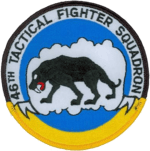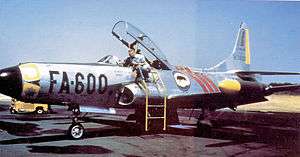46th Fighter Training Squadron
| 46th Fighter Training Squadron | |
|---|---|
|
46th Fighter Training Squadron Fairchild Republic A-10A Thunderbolt II 79-0136 | |
| Active | 1940-1993 |
| Country |
|
| Branch |
|
| Engagements |
|
| Decorations |
|
| Insignia | |
| Emblem of the 46th Tactical Fighter Squadron |
 |
The 46th Fighter Training Squadron is an inactive United States Air Force unit. Its last assignment was with the 917th Operations Group stationed at Barksdale Air Force Base, Louisiana. It was inactivated on 1 October 1993.
History
The 46th, who was initially assigned to the 15th Fighter/Pursuit Group, its history goes back to World War II, when the 15th Pursuit Group was largely destroyed during the 7 December 1941 Japanese attack on Pearl Harbor at Hickam Field.[1]
World War II

After the attack on Pearl Harbor, the squadron was assigned to the VII Fighter Command. Re-equipped initially with P-39 Airacobras and P-40 Warhawks, ts primary mission was the air defense of the Hawaiian Islands. In 1943, the squadron deployed to the Central Pacific Area, engaging in combat from Makin Island in December 1943. Returned to Hawaii and was again re-equipped with very long-range P-38 Lightnings and P-51D Mustangs. In early March 1945 deployed to Iwo Jima, being attached to the Twentieth Air Force. From Iwo Jima, the squadron performed escort missions with B-29 Superfortress bombers bombing the Japanese Home Islands. After the Japanese Surrender in September 1945, the squadron moved to Guam, where it operated until demobilizing and inactivating in October 1946.
United States Air Force
The squadron was redesignated the 46th Fighter-Interceptor Squadron and reactivated in November 1952 at Dover Air Force Base, Delaware and assigned to the 4710th Defense Wing[2] of Air Defense Command. The squadron assumed the mission, personnel, and Lockheed F-94 Starfire interceptors of the 148th Fighter-Interceptor Squadron, which had been called to active service in the expansion of the United States Air Force for the Korean War which was returned to the control of the Pennsylvania Air National Guard.[3] the squadron's mission was the air defense of southeastern Pennsylvania, south New Jersey, Delaware and Maryland. In 1956, as ADC prepared for the implementation of the Semi-Automatic Ground Environment system, the 4710th wing moved to Illinois and the squadron was briefly assigned to the 4709th Air Defense Wing before being transferred to what would become the automated New York Air Defense Sector. The unit was inactivated in 1958.[2]

Was reactivated in 1962 at MacDill AFB, Florida, equipped with swept-wing F-84F Thunderflash tactical fighters. Received new F-4C Phantom II in 1964, one of the first squadrons in the Air Force to fly the new fighter. Conducted tactical fighter combat crew training for the 12th Tactical Fighter Wing. The squadron participated in a variety of exercises, operations and readiness tests of Tactical Air Command, becoming a replacement training unit for F-4 aircrews prior to their deployment to Southeast Asia beginning in 1965. During the 1968 Pueblo Crisis, the squadron deployed fighters to Seymour Johnson AFB, North Carolina, backfilling fighters deployed to South Korea by the 4th Tactical Fighter Squadron. Transferred to the incoming 1st Tactical Fighter Wing in 1970 when the wing was moved from ADC to TAC. Inactivated in 1971, personnel and aircraft being transferred to the 71st Tactical Fighter Squadron when the former 15th TFW units were inactivated.
Reactivated in the Air Force Reserve in 1975 at Grissom AFB, Indiana, receiving A-37B Dragonfly counter-insurgency aircraft returned from the Vietnam War. Provided combat crew training in close air support tactics for USAF and friendly foreign nations until inactivated in 1978, transferring the A-37s to the 706th Tactical Fighter Squadron.
Equipped with A-10A Thunderbolt II ground attack aircraft in 1983 at Barksdale AFB, Louisiana, mission was to be an A-10 Replacement Training Unit (RTU) for Air Force Reserve pilots. Operated the A-10 at Barksdale until inactivated in 1993 as part of the post-Cold War drawdown, aircraft transferred to Davis-Monthan AFB, Arizona where A-10 training was consolidating with the active-duty 355th Wing.
Lineage


- Constituted as the 46th Pursuit Squadron (Fighter) on 22 November 1940
- Activated on 1 December 1940
- Re-designated 46th Pursuit Squadron (Interceptor) on 12 February 1942
- Re-designated 46th Fighter Squadron on 15 May 1942
- Inactivated on 10 October 1946
- Re-designated 46th Fighter-Interceptor Squadron on 11 September 1952
- Activated on 1 November 1952
- Inactivated on 1 July 1958
- Re-designated 46th Tactical Fighter Squadron, and activated, on 17 April 1962 (not organized)
- Organized on 1 July 1962
- Inactivated on 1 July 1971
- Activated in the Air Force Reserve, 1 July 1975
- Inactivated on 1 July 1978
- Re-designated 46th Tactical Fighter Training Squadron, and activated, on 30 September 1983
- Re-designated 46th Fighter Training Squadron on 1 February 1992
- Inactivated on 1 October 1993
Assignments
- 15th Pursuit (later Fighter) Group, 1 December 1940
- 21st Fighter Group, 15 June 1944 – 10 October 1946
- 4710th Defense Wing (later Air Defense Wing), 1 November 1952
- 4709th Air Defense Wing, 1 March 1956
- 4621st Air Defense Wing (later New York Air Defense Sector), 1 October 1956
- 4728th Air Defense Group, 8 February 1957 – 1 July 1958
- Tactical Air Command, 17 April 1962
- 15th Tactical Fighter Wing, 1 July 1962
- 1st Tactical Fighter Wing, 1 October 1970 – 1 July 1971
- 434th Tactical Fighter Wing, 1 July 1975 – 1 July 1978
- 917th Tactical Fighter Wing, 30 September 1983
- 917th Operations Group, 1 August 1992 - 1 October 1993
Stations
|
|
Aircraft
|
|
|
Awards
- Citations: Distinguished Unit Citation Japan, 7 April 1945.
- Service Streamers: None
- Emblem: Blue disc a black sabre-tooth tiger passant in front of a horizontal bank of white clouds. (Approved 11 March 1942.)
See also
List of United States Air Force Aerospace Defense Command Interceptor Squadrons
References
Notes
- ↑ Pearl Harbor History: Why Did Japan Attack?
- 1 2 Maurer, Maurer, ed. (1982) [1969]. Combat Squadrons of the Air Force, World War II (PDF) (reprint ed.). Washington, DC: Office of Air Force History. p. 204. ISBN 0-405-12194-6.
- ↑ Cornett, Lloyd H; Johnson, Mildred W (1980). A Handbook of Aerospace Defense Organization, 1946–1980 (PDF). Peterson AFB, CO: Office of History, Aerospace Defense Center. p. 123.
- ↑ Wheeler Field, Schofield Barracks, Oahu, Locations Of The United States Army Air Force 7 December 1941
Bibliography
![]() This article incorporates public domain material from the Air Force Historical Research Agency website http://www.afhra.af.mil/.
This article incorporates public domain material from the Air Force Historical Research Agency website http://www.afhra.af.mil/.
- Cornett, Lloyd H; Johnson, Mildred W (1980). A Handbook of Aerospace Defense Organization, 1946–1980 (PDF). Peterson AFB, CO: Office of History, Aerospace Defense Center.
- Maurer, Maurer, ed. (1982) [1969]. Combat Squadrons of the Air Force, World War II (PDF) (reprint ed.). Washington, DC: Office of Air Force History. ISBN 0-405-12194-6.
Further reading
- Rogers, Brian (2005). United States Air Force Unit Designations Since 1978., Hinkley, England: Midland Publications. ISBN 1-85780-197-0.
External links
- 15th Fighter Group
- 21st Fighter Group Lineage
- Eastern Mandates (Military History)
- The Air Force Story, http://www.af.mil/shared/media/document/AFD-061205-065.pdf Page 48, Chapter III, Assignment Paradise: Fighter Command

